Search the Community
Showing results for tags 'Supercar'.
Found 246 results
-
Not that many people seem to like the supercars I made up, so here's a real one, a Noble M15. Noble M15 by Henchmen4Hire, on Flickr Noble M15 by Henchmen4Hire, on Flickr Noble M15 by Henchmen4Hire, on Flickr Noble M15 by Henchmen4Hire, on Flickr
-
Hello Lotus, James Bond and Speed Champions fans, The Lotus Esprit S1 is a sports car built by Lotus Cars from 1976 to 1978 at their Hethel, England factory. It has a rear mid-engine, rear-wheel-drive layout and it was featured in the 1977 James Bond film The Spy Who Loved Me, where a car famously converted into a submarine after a road chase. The car used in the underwater scenes is nick-named "Wet Nellie". Building instructions are available on the following link: https://rebrickable.com/mocs/MOC-178962/_TLG_/lotus-esprit-s1-007-james-bond-submarine-conversion It is a studless build in the new, 8 studs wide Speed Champions style. I wanted to create a clean model which is as accurate as possible in this small scale. I prefer the brick built solutions to keep the flexibility of the used parts in further builds, and therefore only two vehicle registration plate stickers are used. My intent was to keep the width-length-height ratio of the real car and this size makes it possible. The model contains lots of details: for example the black stripes on the sides, door handles, detailed tail lights etc.. Maybe the most challenging one was the front and the front bumper with brick built headlights. I tried to fill every unnecessary gaps and therefore some tricky build techniques are used. The car can be converted to submarine. The model has space for two minifigures with helmets or small hairs. Thanks for visiting, _TLG_ Lotus Esprit S1 - James Bond - Instructions 01 by László Torma, on Flickr Lotus Esprit S1 - James Bond - Instructions 02 by László Torma, on Flickr Lotus Esprit S1 - James Bond - Instructions 03 by László Torma, on Flickr Lotus Esprit S1 - James Bond - Instructions 04 by László Torma, on Flickr Lotus Esprit S1 - James Bond - Instructions 05 by László Torma, on Flickr Lotus Esprit S1 - James Bond - Instructions 06 by László Torma, on Flickr Lotus Esprit S1 - James Bond - Instructions 07 by László Torma, on Flickr Lotus Esprit S1 - James Bond - Instructions 08 by László Torma, on Flickr Lotus Esprit S1 - James Bond - Instructions 09 by László Torma, on Flickr Lotus Esprit S1 - James Bond - Instructions 10 by László Torma, on Flickr Lotus Esprit S1 - James Bond - Instructions 11 by László Torma, on Flickr
-
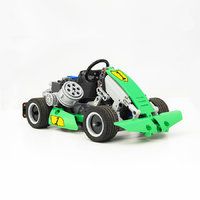
Ultimate 6+N+R Sequential Gearbox
Anto posted a topic in LEGO Technic, Mindstorms, Model Team and Scale Modeling
INTRODUCTION This gearbox is the successor of my previous 8+N+R-gearbox. It is based on the new parts released on the Yamaya MT-10 SP #42159. Thanks to these, I could make a new and better gearbox for 1:8 manual supercars. Thanks to the 8 positions by rotation, I made a 6+N+R gearbox. The best arrangement I found was to put 2 cylinders between 2 shafts, each cylinder controlling 2 forks. Thus, I would need 2 cylinders to make the 8 positions I wanted. VIRTUAL DESIGN I started with simulations in Excel when the parts were not available yet. The purpose was to virtually recreate the functioning of the new rotary cylinders to find out a configuration that worked. So, I reproduced the sequence of the cylinders. Then, I created an offset between the 2 cylinders. To make the best gearbox possible, it was necessary to obtain: Reverse gear on an extremity of a shaft Not 2 gears engaged at the same time on the same shaft EXCEL TABLE The Excel table may seem hard to understand, but the main difficulty is because I made written in French! The first column represents the positions of the rotary cylinders. The second column is used to create an offset between the 2 cylinders. I tested all the configurations and keeped the ones that respected the criteria above. Then, I used the supposedly working configurations to calculate the possible gear ratios. The sub-table called “Transitions” corresponds to the ratio between the two main shafts. Then, on the sub-tables on the right, I put the gears on the primary and secondary shafts to get 3 different ratios on each shaft, placed in the correct sequence, for each remaining possible configuration. I got only 2 possible configurations (A and B). Other configurations exist, but they are symmetries of these two configurations, so they are useless. I finally came out with only one possible configuration, which is the one I realized in Stud.io and in real life. IMPROVEMENTS Compared to my previous gearbox, this new version features: Way better efficiency More compact, easier to integrate into a chassis More reliable gear selector More realistic and easier to understand The shifter can be less robust The input and the output are centred, and can easily be moved It is reversible, meaning that you can power both the input and the output Gears better staged HOW IT WORKS? The way it works is close to a dual-clutch gearbox - however, the exact same operation cannot be achieved due to the way the sequence of a rotary changeover cylinder is made. The ratios are better staged than the ones of my previous gearbox. The reverse gear is situated between the 1st and the 2nd gear, making it more realistic. R: -0.375 N: 0 1st: 0.25 2nd: 0.45 3rd: 0.50 4th: 0.75 5th: 0.90 6th: 1.50 A simple mechanism prevents from shifting from 6th to reverse gear. This mechanism can easily me moved to another place (for instance close to the shifter) though. The centre changeover cylinder is used to create a 45° offset between the two other cylinders. However, to spare a part, you can use one of the following assemblies. VIDEO REBRICKABLE LINK Here is the Rebrickable link if you want to test this gearbox! https://rebrickable.com/mocs/MOC-171508/Anto/ultimate-6nr-gearbox-with-forks/#details I’m wondering what the gearbox on this summer’s supercar will look like. It should either be pretty similar, or totally different. What do you think? -
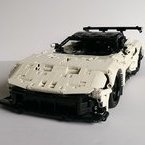
[MOC] 1:8 Aston Martin Vulcan
mihao posted a topic in LEGO Technic, Mindstorms, Model Team and Scale Modeling
It's been a while since my last post, and this time I bring you my most recent MOC, a 1:8 scale Aston Martin Vulcan. The actual size is 58cm long, 24cm wide, and 13cm tall. This MOC is designed to be a combination of a static version and a dynamic version, meaning dynamic parts (motors, lights, and battery) can be directly mounted to the static version and it can run. In order to achieve this, I designed it in a way that the entire body can be completely detached from the frame. This has been a standard for my recent several 1:8 MOCs. Another significant benefit of this design choice is the ease of fixing issues deep down in the frame without needing to break down the whole body. Given that this car has a V12 engine at the front and is a rear-wheel-drive car, the drivetrain from the rear wheels to the engine has to collide with the HOG handler because both of them will go through the central line of the frame. My solution for this is to use a freewheel (in blue) to cross, as depicted in the following picture. I tried my best to reduce the size of the MOC, but it's still very big and very heavy. In order to make it motorized with changing speed, this is the gearbox I came up with. The orange part can slide to change gear ratio between 0.6 (12/20) to 1.67 (20/12). The pink 1x2 thin lift arms will hold it in position. Two buggy motors will be mounted on both sides of the top-most orange 5x7 frame. I have to use a pair of gear to reduce the speed and increase torque for each buggy motor before connecting into the 5x7 frame. I experimented with different pairs, and the only feasible one is still the 12-tooth and the 20-tooth, which can provide enough torque to kick off the car from a stationary state but not too much to grind the gears. Here is a video about how it runs with the high gear. Here is the full feature list of this MOC: Independent suspension on all wheels. A functioning steering wheel and HOG (Hand of God). An openable hood. Doors that swing open with a spring lock. A working V12 engine. Two-speed gearbox. Detachable body from the frame. And here is the RB link for this project LEGO MOC 1:8 Aston Martin Vulcan Static Version by Lego__Bee | Rebrickable - Build with LEGO I hope you enjoy seeing this project come to life as much as I enjoyed building it. Thanks! -
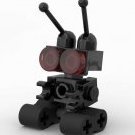
[MOC] Bone Shaker (42127 alternate)
A Great Builder posted a topic in LEGO Technic, Mindstorms, Model Team and Scale Modeling
When I bought the 42127 set this was the first alternate I could think of. I finally had some time to work on this. I hope you all like it. I used the Forza Motorsport version of this classic Hot Wheels as inspiration. Instructions: https://rebrickable.com/mocs/MOC-176634/A_Great_Builder/bone-shaker/#details- 4 replies
-
- hot wheels
- hotrod
- (and 5 more)
-
Hello Corvette and Speed Champions fans, The Chevrolet Corvette (C3) is the third generation of the Corvette sports car that was produced from 1967 until 1982 by Chevrolet for the 1968 to 1982 model years. Engines and chassis components were mostly carried over from the previous generation, but the body and interior were new. It set new sales records with 53,807 produced for the 1979 model year. Building instructions are available on the following link: https://rebrickable.com/mocs/MOC-176144/_TLG_/corvette-c3-stingray It is a studless build in the new, 8 studs wide Speed Champions style. I wanted to create a clean model which is as accurate as possible in this small scale. I prefer the brick built solutions to keep the flexibility of the used parts in further builds, and therefore only two vehicle registration plate stickers are used. My intent was to keep the width-length-height ratio of the real car and this size makes it possible. The model contains lots of details: for example the front bumper, the emblematic side grills, the side view mirrors, the embedded tail lights, the fuel cap etc... I tried to fill every unnecessary gaps and therefore some tricky build techniques are used. The instructions includes some modification ideas, for example front blinker and alternate side grill, see picture 6, and luggage rack, see picture 5. The model has space for two minifigures with helmets or small hairs. Thanks for visiting, _TLG_ Corvette C3 - instructions 01 by László Torma, on Flickr Corvette C3 - instructions 02 by László Torma, on Flickr Corvette C3 - instructions 03 by László Torma, on Flickr Corvette C3 - instructions 04 by László Torma, on Flickr Corvette C3 - instructions 05 by László Torma, on Flickr Corvette C3 - instructions 06 by László Torma, on Flickr Corvette C3 - instructions 07 by László Torma, on Flickr Corvette C3 - instructions 08 by László Torma, on Flickr Corvette C3 - instructions 09 by László Torma, on Flickr Corvette C3 - instructions 10 by László Torma, on Flickr Corvette C3 - instructions 11 by László Torma, on Flickr
- 4 replies
-
- chevrolet
- corvettec3stingray
- (and 26 more)
-
Hello Lamborghini and Speed Champions fans, The Lamborghini Diablo is a high-performance mid-engine sports car built by Italian automobile manufacturer Lamborghini between 1990 and 2001. It is the first production Lamborghini capable of attaining a top speed in excess of 320 kilometres per hour (200 mph). Building instructions are available on the following links: It is a studless build in the new, 8 studs wide Speed Champions style. I wanted to create a clean model which is as accurate as possible in this small scale. I prefer the brick built solutions to keep the flexibility of the used parts in further builds, and therefore only one Lamborghini logo sticker and a standard vehicle registration plate sticker are used. My intent was to keep the width-length-height ratio of the real car and this size makes it possible. The model contains lots of details: for example the emblematic taillights, the side air intakes, the side view mirrors and rear details with the double exhausts etc... Maybe the most challenging one was the hood tilt and some half stud offsets in the inside structure. I tried to fill every unnecessary gaps and therefore some tricky build techniques are used. The model has space for two minifigures with helmets or small hairs. Thanks for visiting, _TLG_ Lamborghini Diablo - Instructions 1 by László Torma, on Flickr Lamborghini Diablo - Instructions 2 by László Torma, on Flickr Lamborghini Diablo - Instructions 3 by László Torma, on Flickr Lamborghini Diablo - Instructions 4 by László Torma, on Flickr Lamborghini Diablo - Instructions 5 by László Torma, on Flickr Lamborghini Diablo - Instructions 6 by László Torma, on Flickr Lamborghini Diablo - Instructions 7 by László Torma, on Flickr
-

1:10 Scale Motorized Acura/Honda NSX Supercar
Zerobricks posted a topic in LEGO Technic, Mindstorms, Model Team and Scale Modeling
After building the 1:8 scale Spano GTA, I wanted to make something more compact, yet even more functional for the BuWizz camp 2021, which got postopned to 2022. The rules behind this model stated to build a 1:10 scale representation of a real existing car, which has to have a working gearbox, fake engine and working steering wheel. After researching different types of super and hypercars, I chose the Acura/Honda NSX since it had several good pros compared to the more famous brands like Ferrari or Lamborghini: The real car has a smaller profile, which means a lower weight It uses a hybrid AWD system, which would come in handy for the LEGO model for accelerating and braking on all wheels Engine powering is a V6, which doesn't take as much space as the typical V8, V10 or even V12 Since it's a less known supercar, my LEGO version could be the first one in such scale I used a simillar technique as with Spano GTA where I imported the 3D model into the Lego Digital Designer and used it as a 3D reference. Using this technique I ended up with a really close representation, and it really shows: As you can see in the gif above, not only does the model look very good, it's also full of functionality: 4x BuWizz motors for driving All wheel drive 2 Speed gearbox Working fake V6 coupled directly to the drive motors Working steering wheel 2x BuWizz 3.0 for control Double wishbone suspension on all wheels Dimensions and weight ended up as following: Length: 45 cm Width: 20 cm (without mirrors) Height: 12.5 cm Weight: cca 1,5 kg Here is how the model's underside looks like, drive motors are driving two independent gearboxes in order to evenly spread the mechanical load. This kind of a setup also cancels out any side forces on the central drive axle, thereby reducing friction and wear: In order to cram all the powertrain components in the rear the drive motors are placed in a V shape. This way there is just enough space between them for a functional V6 engine and a PU medium motor which switches the gearbox: Thanks to the compact powerline and driveline, the interrior is very spacious and both seats are almost 1:8 scale sized, measuring 6 studs wide. There are even stoppers and interrior details on the doors themselves: ž The end performance of the model is higher than what I expected, there is enough torque to freespin all 4 wheels, jump over ramps and top speed in high gear is almost 20 km/h! You can see how well it performs the video: To conclude, this is my first 1:10 scale supercar which also ended up extremely compact, functional, robust and good looking. I also think a 1:10 scale may be beneficial when it comes to reliability and robustness, since models tend to weight half the weight of their 1:8 counterparts while still incorporating a simillar level of functionality and details. Having said that, this will not be my last 1:10 supercar and I think for the next one I will ditch the gearbox and simply drive the wheels directly from the motors without any weak differentials. -
Hello Corvette, A-Team and Speed Champions fans, the Chevrolet Corvette C4, colloquially known as the 'Vette, is a two-door, two-passenger sports car manufactured and marketed by Chevrolet across more than 60 years of production and eight design generations. The fourth-generation was the first complete redesign of the Corvette since 1963 and it is known for its sleek look. It was produced from 1983 to 1996. This color scheme of this model is based Faceman's 1984 Corvette from "The A-Team" which is an American action-adventure television series that ran on NBC from January 1983 to March 1987 about former members of a fictitious United States Army Special Forces unit. Building instructions are available on the following links: It is a studless build in the new, 8 studs wide Speed Champions style. I wanted to create a sleek model which is as accurate as possible in this small scale. I prefer to minimize the use of stickers to keep the flexibility of the used parts in further builds, and therefore this model include only two vehicle registration plate stickers. My intent was to keep the width-length-height ratio of the real car and this size makes it possible. The model contains lots of details: for example the emblematic color scheme with the red and black stripes on the sides, the glass hatchback, the side-view mirrors, the tiltable seats etc.. Maybe the most challenging one was the iconic rear side with the vehicle registration plate, here there is a half stud offset. I tried to fill every unnecessary gaps and therefore some tricky build techniques are used. The model has space for two minifigures. I suggest to use small hairs. Without the seats minifigures with bigger hairs can be used too if they are leaned back. Thanks for visiting, _TLG_ Corvette C4 - A-Team, Instructions 1 by László Torma, on Flickr Corvette C4 - A-Team, Instructions 2 by László Torma, on Flickr Corvette C4 - A-Team, Instructions 3 by László Torma, on Flickr Corvette C4 - A-Team, Instructions 4 by László Torma, on Flickr Corvette C4 - A-Team, Instructions 5 by László Torma, on Flickr Corvette C4 - A-Team, Instructions 6 by László Torma, on Flickr Corvette C4 - A-Team, Instructions 7 by László Torma, on Flickr
- 8 replies
-
- the a-team
- a-team
- (and 17 more)
-
Hello Lamborghini and Speed Champions fans, The Lamborghini Aventador LP700-4 is a mid-engine sportscar produced by the Italian automotive manufacturer Lamborghini. In keeping with Lamborghini tradition, the Aventador is named after a Spanish fighting bull that fought in Zaragoza, Aragón, in 1993. The Aventador is the successor for the Murciélago and was made by hand in Sant'Agata Bolognese, Italy. Building instructions are available on the following links: https://rebrickable.com/mocs/MOC-149528/_TLG_/lamborghini-aventador-lp700-4 It is a studless build in the new, 8 studs wide Speed Champions style. I wanted to create a clean model which is as accurate as possible in this small scale. I prefer the brick built solutions to keep the flexibility of the used parts in further builds, and therefore only two types of stickers are used: simple black ones to cover the visible parts of the headlights in the front air intakes, and the Lamborghini logo. My intent was to keep the width-length-height ratio of the real car and this size makes it possible. The model contains lots of details: for example the emblematic headlights, the front and side air intakes, the side view mirrors and rear details with the wide exhaust etc... Maybe the most challenging one was the hood tilt and some half stud offsets in the inside structure. I tried to fill every unnecessary gaps and therefore some tricky build techniques are used. The two trans-clear headlight parts "Slope, Inverted 45 2 x 1" (part 3665) are very rare, it never released in a set, but is available on Bricklink in some webshops. Of course they can be replaced for example by white, black, light bluish gray or dark bluish gray versions. The parts 86996 and 42446 are also rare, but the picture 7 shows an alternate side view mirror solution. It is a very low build, and can roll well only on flat surfaces. It is more of a display model then a toy for small children. The model has space for two minifigures: one with small hair or helmet in the driver's seat and one either without hair or withour leg. Thanks for visiting, _TLG_ Lamborghini Aventador - Instructions 1 by László Torma, on Flickr Lamborghini Aventador - Instructions 2 by László Torma, on Flickr Lamborghini Aventador - Instructions 3 by László Torma, on Flickr Lamborghini Aventador - Instructions 4 by László Torma, on Flickr Lamborghini Aventador - Instructions 5 by László Torma, on Flickr Lamborghini Aventador - Instructions 6 by László Torma, on Flickr Lamborghini Aventador - Instructions 7 by László Torma, on Flickr Lamborghini Aventador - Instructions 8 by László Torma, on Flickr Rear wing version added :), it is a free addition the original design: Lamborghini Aventador rear wing - Instructions 1 by László Torma, on Flickr Lamborghini Aventador rear wing - Instructions 2 by László Torma, on Flickr Lamborghini Aventador rear wing - Instructions 3 by László Torma, on Flickr
-

[MOC] Prodrive BRX Hunter (Alternative build for 42141)
A Great Builder posted a topic in LEGO Technic, Mindstorms, Model Team and Scale Modeling
This is my second alternative build of McLaren F1 42141. This time I was inspired by Dakar rally and I made a version of Sebastien Loeb's Prodrive RX Hunter. This is the 2022 version and just like all my Technic model based on a real car; I invested a lot of effort into making it as close as possible to the real counterpart. I was able to reproduce the position of the engine, The curved shaped roof, doors and even the spare tire!Functions:- Independent suspension in all wheels- V6 fake engine (located inside the cabin just like the real car!)- HoG steering- Opening doors (Butterfly doors)I am no good at stickers but I made a basic sticker sheet that I am including as optional.Can't wait for the Audi RS Q e-tron???Don't worry! This one will keep you busy. Instructions on rebrickable as always: https://rebrickable.com/mocs/MOC-152876/A_Great_Builder/prodrive-brx-hunter/#details -

[MOC] ICARUS Supercar
Madoca 1977 posted a topic in LEGO Technic, Mindstorms, Model Team and Scale Modeling
Hello everyone! This is my latest creation. ICARUS Supercar Introduction The name comes from a man who desired to fly higher using his technology. Many times I have tried to realize the speed what supercar MOC should perform. I needed “wing” called buggy motor, but all I had is a bunch of PF motors. So I connected motors together using “wax” called SBrick. Like Icarus of Greek myth, higher speed and torque may be lethal for the model itself... The result is here in the video! Weight: 1760g Propulsion: 4x PF L motor for rear wheel drive Steering: PF Servo motor Front and rear lights: 2x PF light Powered by: 2x SBrick and 2x 8878 rechargeable battery box Features: independent suspension for all wheels working steering wheel manually adjustable rear spoiler opening doors, hood, engine cover, glove box Drivetrain You may think it is not fast enough, but for me it was a relatively success. Surprisingly, gears and CV joints have never damaged or popped out even at the time of maximum acceleration. Although I had designed its drivetrain carefully, I was not sure if small bevel gears in differential withstand the load. Two 20T bevel gears of each side divide the load from differential equally. In this setting differential doesn't move back and forth easily. That means differential and 20T bevel gears hardly ever disengage. So they keep rotating smoothly even under high load. In this MOC there are three L motors (and two SBricks, two battery boxes, bunch of wiring) on the supposed location of V8 engine. So if someone build manual version with gearbox, there would be enough room for it. Body design As expected, building 1:10 scale supercar was very hard. Especially the body work. I've built one three years ago, but it was primitive MOC in every way. New MOC is heavily inspired by modern McLaren supercars. I tried to build their curved shapes using rather technic panels than flex axles. Front and rear light section happened to become different from the original mainly because of the positon of LED. Though finished model is not a copy of P1, I am happy with the result of realizing proper mid-engine proportion. Building instructions: http://rebrickable.c...icarus-supercar I hope you like it!- 220 replies
-

[Intructions available] Ferrari F40 1:10 (V2)
sebulba56 posted a topic in LEGO Technic, Mindstorms, Model Team and Scale Modeling
Link to the instructions : https://rebrickable.com/mocs/MOC-144042/Sebulba56/ferrari-f40-supercar-110-scale/#details Here is my latest creation, a 1:10 scale replica of the iconic Ferrari F40. This project was a true labour of patience, and I am proud to say that I was able to incorporate all the functions that make a supercar and to capture the essence of the design of the F40. I already worked on the F40 and posted it almost 2 years ago (link right below). It was a cool model but I still had always that feeling that I could do better. This feeling was emphasized by the other people of this forum that worked on this Ferrari like @lnteknik or very recently @Lox Lego. So I went back to my pieces and started to work from scratch on a new iteration of this legendary car. To sum up : I changed almost everything. One of the key features of the Lego model is the functional 5+R gearbox, which allows the car to shift through its gears just like the real-life F40. This was a particularly challenging feature to implement, but it really adds to the overall playability of the Lego model. The gearbox is designed to be smooth and efficient, making it easy to shift between gears and control the fake engine’s speed. The gearbox was inspired by GrayGear from Eurobrick, here is a link to his topic : His gearbox is a 6 speed, I worked on it to implement a reverse gear. Note that I reproduced the particular patern of the F40, the R replace the 1, the 1 replace the 2 and so on. In addition to the gearbox, I also included a functional opening mechanism for the doors, front trunk, and rear engine hood. This was a challenging aspect to incorporate into the design, but I am thrilled with how well it turned out. Users can easily open and close these components, further enhancing the interactive and realistic nature of the Lego model. Those components can also be retired to reveal the chassis of the car in a modular-ish way. Attention to detail was also a top priority for me during the design process. I made sure to include accurate design elements such as the air intake on the doors and the sharp, angular lines of the car's bodywork. I also ensured that the proportions of the model were as true-to-life as possible, making it instantly recognizable as an F40 to car enthusiasts and Lego fans alike. I am also extremely pleased with how the engine and its details turned out in the model. The attention to detail and accuracy of the design truly showcases the iconic engine of this legendary car. Furthermore, I the steering mechanism can be controlled by the steering wheel or by a removable HOG, which adds to the overall control of the Lego model. The steering is designed to be responsive and smooth, allowing to easily maneuver the car in any direction. Finally, I included the iconic pop-up headlights, which can be activated using a small wheel in the dashboard. This adds a fun and interactive aspect to the model, and further enhances the overall attention to detail that went into the design. Overall, I am extremely proud of this creation, and I believe that the inclusion of these unique and functional features truly sets it apart from other Lego Technic models. The attention to detail, accurate design elements, and functional components make this model a true tribute to the iconic Ferrari F40. Link to the instructions : https://rebrickable.com/mocs/MOC-144042/Sebulba56/ferrari-f40-supercar-110-scale/#details- 13 replies
-
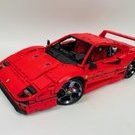
Ferrari F40 - 1:8 Scale - Instructions ready!
Lox Lego posted a topic in LEGO Technic, Mindstorms, Model Team and Scale Modeling
Driving Ferrari's twin-turbo exotic is the closest you'll ever come to experiencing a nervous breakdown. Designed to commemorate Ferrari's 40th anniversary, the F40 is highly revered among gearheads. Ferrari Outdoors - when the sun ☀️ rises by lachlan cameron, on Flickr And gears ⚙️ it has… this iconic car is true to the original, a 5 speed gearbox + reverse, HOG (manual) steering with working steering wheel, opening doors, hood and engine cover, pop up headlights, opening doors, the classic black stripe and a realistic interior. The framework is solid, the roof can be lifted from the B pillars. Ferrari F40 by lachlan cameron, on Flickr Using the new Daytona rims, this car looks like a track ready machine. Very cool to be building with new panels and parts, and to understand the design, not your average supercar shaping! Enjoy these white room shots of the #F40 in technic form and scroll thru the photos for all the details! Ferrari F40 by lachlan cameron, on Flickr Rims chromed by @bubul_chrome_ Stickers by @fwartstckr Printed tires by @brickvisions Ferrari Outdoors - when the sun ☀️ rises by lachlan cameron, on Flickr #lego #supercar #newrelease #hdrphotography #moc #influencer #f40#ferrari #classiccar #iconic Ferrari F40 by lachlan cameron, on Flickr Ferrari F40 by lachlan cameron, on Flickr Ferrari F40 by lachlan cameron, on Flickr Ferrari F40 by lachlan cameron, on Flickr Ferrari F40 by lachlan cameron, on Flickr Ferrari F40 by lachlan cameron, on Flickr Ferrari F40 by lachlan cameron, on Flickr -

[MOC][WIP] Lamborghini Aventador LP700-4
damian_kane_iv posted a topic in LEGO Technic, Mindstorms, Model Team and Scale Modeling
Part of what got me into LEGO Technic years ago was an interest in designing a MOC of Lamborghini's original Aventador, the LP700-4. After a lot of procrastination, I've finally started on it. I'm not 100% happy with the chassis and I put compromises in so that I could test the fit and scale of various components. This will be a 1:10 scale model and it's my intention to implement a modified version of the gearbox from the Pimp my Lamborghini Project (https://rebrickable.com/mocs/MOC-46782/jb70/42115-pimp-up-my-lamborghini/#details). I also intend on implementing some form of pushrod suspension for the front + back wheels and the original air brake system. There are a lot of things I like about the current gearbox, but there are significant space limitations I need to take into account. The gearbox may need to be redesigned but right now it fits nicely in the chassis. I'm currently having a challenge implementing the DNR and gear shifters in the small space. I'm very happy with the rear suspension as it is compact, to-scale, and captures a lot of the aspects of the Aventador's pushrod-style suspension. I've designed it to have more travel than a supercar normally would because I prefer it that way for Technic models. The front suspension is a mess of compromises to keep height down since at this scale I have 1 or 2 studs more at most before I hit the hood. Here there are many more challenges before I'd consider it done. I haven't found a 100% perfect solution yet, but I have managed to maintain my height limit by expanding laterally. I'm having trouble designing a steering rack with a good geometry, but the current version is adequate for now. The mechanism is very similar to the rear suspension, only it has been flattened and widened to accommodate steering and front wheel drive. I might be tempted to raise the height by a stud, but I'd have to begin on front fenders to see what the height limit will be. Steering is wonky but adequate for now. -

[HELP] FWD with Transversely Mounted Engine and Gearbox
AttentionSpanner posted a topic in LEGO Technic, Mindstorms, Model Team and Scale Modeling
Hi everyone, This will be my first project in a while, and my first project here. I want to try and make a 2WD (hopefully FWD, but RWD is fine if things get difficult), 4-cylinder car with a transversely mounted engine and gearbox assembly, and hopefully as a studless construction. I started mocking-up some of the gearbox in LDD (I know, not the best tool), and the results have not been too encouraging (space-wise). I haven't yet figured how to post photos, but I will when I do -
Hello Ferrari and Speed Champions fans, The Ferrari Daytona SP3 is a limited production mid-engine sports car produced by Italian automobile manufacturer Ferrari, unveiled on 20 November 2021 for the 2023 model year. The design references to 1960s race cars, it is a modernization of the 330 P4, with the body work consisting distinguished low driver's seating position, raised front and rear wheel arches, and the Targa top design. Building instructions are available on the following links: https://rebrickable.com/mocs/MOC-131689/_TLG_/ferrari-daytona-sp3 https://www.mocsmarket.com/lego-mocs/ferrari-daytona-sp3/ It is a studless build in the new, 8 studs wide Speed Champions style. I wanted to create a sleek model which is as accurate as possible in this small scale. I prefer the brick built solutions to keep the flexibility of the used parts in further builds, and therefore only Ferrari logo and simple light gray head lights stickers are used. My intent was to keep the width-length-height ratio of the real car and this size makes it possible. The model contains lots of details: for example the emblematic front and hood grilles, the side and rear intakes, the side view mirrors etc... Maybe the most challenging one was the brick built narrow black and red lines on the front. I tried to fill every unnecessary gaps and therefore some tricky build techniques are used. On the pictures the red grills on the front are connected only by half studs. However, if you prefer more sturdy models, then full connection is usable too, it is a bit less accurate, but looks decent too. It is a very low build, an can roll well only on flat surfaces. The model has space for two minifigures. I suggest to use helmets, or small hairs, and the upper part of the seats have to be removed in this case. Thanks for visiting, _TLG_ Ferrari Daytona SP3 - instructions 1 by László Torma, on Flickr Ferrari Daytona SP3 - instructions 2 by László Torma, on Flickr Ferrari Daytona SP3 - instructions 3 by László Torma, on Flickr Ferrari Daytona SP3 - instructions 4 by László Torma, on Flickr Ferrari Daytona SP3 - instructions 5 by László Torma, on Flickr Ferrari Daytona SP3 - instructions 6 by László Torma, on Flickr Ferrari Daytona SP3 - instructions 7 by László Torma, on Flickr
-

[WIP] Lamborghini Aventador SVJ 1:8
ibessonov posted a topic in LEGO Technic, Mindstorms, Model Team and Scale Modeling
Hi everyone, this time I want to show you another work-in-progress MOC, but this one is more recent. The reason why I want to do this is quite obvious - LEGO releases their Lambo this year, and I am also aware of at least one Aventador MOC coming soon. We should have even more Lamborghinis, they are awesome and I can't wait to see these models. My version is a dark blue + white model in 1:8 scale with some basic functions: Steering with working steering wheel. Openable scissors doors. 7+R gearbox. Remote control using a single Control+ hub: 2 coupled XL motors for drive; L motor for steering; L motor to change speeds. This time I decided to build everything independantly and simultaniously. It actually helped me to become much more productive. I'll start with the bodywork. It's not completed and is built around a very crude carcass. I'm trying to concentrate on the shape only. There will be enough space on the inside, I'm taking this into account while building. As you see, it's about 60% completed. Front section is not done yet, but the back looks almost completed and I really like how it turned out. Reminds me a "snowboard glasses" a little (don't know how to call them but I'm sure you get what I mean): Of course, these gaps will have black background in the future and I will add some filler to them as well. Rear wing also looks completed, it might be my favorite part of the build, here you can see it from another side: Now I want to show a door closely. I tried to replicate scissors mechanism as closely as I could. First version used shock absorber and was way too big. The proble is that it has to be very close to the front wheel, it's pretty hard to do. Second version required 3 small rubber bands to hold door's weight. On the following photos you will see a third version. This is how it looks being closed: This is the first step of opening when you open it just like a regular car's door: And this is how it looks when you open it in a different plane. It holds itself locked with two rubber bands that you can see at the bottom: Here's a shot from the front with both doors opened. You can see that the door on the right has "old" design, I improved on it already: Next two pictures are showing caliper on the front wheel. I wanted it to be angled just like on the real car so I had to be creative: Yes, this is a sausage piece. Calipers on the rear will also be angled, but with more conventional build. I don't have it right now so the picture will be in one of the following updates. Now car's internals. Here you can see a gearbox and rear wheels. 3 motors are clearly visible. 4th motor will be in front of the hub. The idea is that L motor will change speeds by rotating by 180 degrees, this can be done programmatically rather then mechanically. But it doesn't mean that the build is simple, because it's not. I used only one of those new orange "wave selector" gears, everything else is basically a huge improvement over the gearbox from my LaFerrari MOC, but it's 1.5 times bigger because of that "reverse" speed I added. It's actually pretty fun that I managed to use a 40 tooth gear in this model. I guess I could use 36 + 2x28, but I don't have 28 tooth gears yet: Here's a view of the bottom. A huge con of the model can be seen here - it has no central diff, but still I expect all 4 wheels to be driven. On the other hand, I left a lot of holes so I can see gears turning: This construction is not rigid enough in several points, I think I will have to completely rebuild it and ensure that it is strong enough. It's already pretty smooth and if motors won't be able to handle the weight then I can play with the gear ratios from motors - there are dedicated places in the gearbox for this exact purpose. I hope that it will become a good model and you'll like it. Thank you! -

[MOC][WIP] Nissan SKYLINE R34 GT-R
Gray Gear posted a topic in LEGO Technic, Mindstorms, Model Team and Scale Modeling
Before I disappoint anyone I want to say that this project is still in a phase where I am not sure if I will actually build the car. Right now I just want to see if I can fit a 6speed manual transmission with AWD and 4 wheel steering into one car and make it work reliably. But if things do work out I will probably finish the R34 project because the R32,R33 and R34 are the only japanese cars I know of to combine AWD and 4WS This is my current progress: I managed to squeeze a gear rack into the transmission I used for my R32 GT-R to give it 4 wheel steering. I also had to decrease the overall width on each side by 1 stud to give the tires space to turn without rubbing here you can see the gear rack placement. I had some massive issues clearing the two differentials, but it all worked out very well in the end. And I only had to increase the transmission length by 1 stud! I am satisfied. Bellyshot. The 20T bevel gear engaging with the center diff will be replaced with the new 20t straight cut gear once I get my hands on it. Thanks again to @Zerobricks for trying out if this combination would work. Gray Gear -
MOC#91 Lamborghini Countach 80's It is the 2nd creation suggested by my channel's viewer. The scissor doors and the engine hood can be opened. Welcome to check out my stop-motion animation for this MOC: More MOC on my homepage: https://www.bricksboy.com/moc
-
- moc
- lamborghini
-
(and 4 more)
Tagged with:
-
Hello :) Topic for placing in one place my self-made products 8pin wide in the scale of Speed Champions. Pleasand viewing! I will be glad to comments with wishes and criticism :)
- 102 replies
-
- minifigures
- car
- (and 4 more)
-
Hello Speed Champions fans, Black Arrow is a ficticious hypercar which was designed for a "Hypercar building contest" hosted by sfh_bricks on Instagram. I tried to design something really cool inspired by the cyberpunk culture. Building instructions are available on the following links: https://rebrickable.com/mocs/MOC-119144/_TLG_/black-arrow-hypercar-concept It is a studless build in the new, 8 studs wide Speed Champions style. Some rules had to be followed: only certain types of car bases, wheels, fenders and windscreen are allowed, cockpit have to be closed, fixed dimensions (wheelbase, width, and maximum length), build must fit a full minifig with helmet. I prefer the brick built solutions to keep the flexibility of the used parts in further builds, and therefore stickers are not used. My intent was to keep the build smooth and to add lots of details: for example the air intakes, the rear wing, the side view mirrors etc. . Maybe the most challenging one was the double headlight. I tried to fill every unnecessary gaps and therefore some tricky build techniques are used. There are two versions of the front assembly : 1) the double headlight version which is a bit more extreme and 2) the simple headlight version which is more solid and sturdy. The model has space for one minifigure. I suggest to use a helmet or small hair. Thanks for visiting, _TLG_ Black Arrow 01 by László Torma, on Flickr Black Arrow 02 by László Torma, on Flickr Black Arrow 03 by László Torma, on Flickr Black Arrow 04 by László Torma, on Flickr Black Arrow 05 by László Torma, on Flickr Black Arrow 06 by László Torma, on Flickr Black Arrow 08 by László Torma, on Flickr Black Arrow 07 by László Torma, on Flickr
-
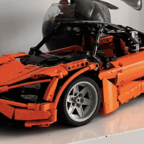
McLaren 720s 1:10 scale
tiledfloor posted a topic in LEGO Technic, Mindstorms, Model Team and Scale Modeling
After many years of work, I am proud to present my take on the McLaren 720s in 1:10 scale. Lego 1:10 McLaren 720s by @tiledfloor, on Flickr It took 4 different iterations of chassis to get to this final version. I started this project with (almost) no experience in Technic MOCs, so I expected this to be the case. The first version was in 1:10 scale, had an 8-speed gearbox (which couldn't shift reliably), was wobbly as could be, and looked abhorring. The second version was in 1:8, -for some reason I thought that my first technic MOC could be THAT large without encountering many problems- I quickly realized how wrong I was. The building process was infinitely harder than in 1:10 due to the required stability and stiffness and added connections between components. This version had a really unique mechanism that I hadn't seen anywhere else though: adjustable drive modes, thanks to small linear actuators controlling the stiffness and travel of the shock absorbers. (you can find a video of the mechanism in action here:) Suspension with adjustable stiffness by @tiledfloor, on Flickr This version also had remote door controls, but after many problems regarding part count, sturdiness etc. I quickly realized that 1:10 was a better suited building scale for me. And so came the final two iterations, the first was almost a 1:1 copy of Dirk Klijn's mp4-12c, but after completing the chassis, I dismantled it to create one that allowed me to add a couple more functions, but I can safely say Dirk's model was the one that inspired me and taught me the most throughout my journey, along with Bruno Jensen's P1 and Charbel's 720s. And the final one was the one that I was finally satisfied with… Lego 1:10 McLaren 720s by @tiledfloor, on Flickr I wanted it to be completely modular, meaning that every single mechanism could be separated from all of the surrounding components. This was the most difficult part of the building and designing process. To achieve this, I settled on a transverse 4-speed sequential gearbox (IIRC, it was borrowed from Charbel’s 8 speed design), a custom made v8 which would sit as low as possible to allow for some detailing on top. The most difficult part of the chassis was the one-piece carbon monocoque also present in the real deal. Lego 1:10 McLaren 720s by @tiledfloor, on Flickr It had to be stiff, allow for two functions to pass through it (gear shifting and active aerodynamics), and still fbe as close to the real McLaren as possible form-wise. Lego 1:10 McLaren 720s by @tiledfloor, on Flickr The modularity also presented many problems mainly relating to the longitudinal stiffness, and I must admit, I wasn’t able to solve all of them, which resulted in a chassis that bends a bit when the suspensions are activated. Though overall it does generally behave as a single-piece chassis, and driving it around feels stable. Lego 1:10 McLaren 720s by @tiledfloor, on Flickr The rear axle is perhaps the most compact, stable and best looking part of the chassis imo. Lego 1:10 McLaren 720s by @tiledfloor, on Flickr After the chassis came the bodywork. It has many, many, MANY illegal connections that bend and induce torsion in long beams and panels. But overall, I am actually quite happy with the way the body turned out. The lines are as smooth as I find reasonably possible in this scale, and the proportions are mostly accurate. The car sits as low as I wanted it to, and has many of the original curves and lines that make the car recognizable imo. (most importantly, it passes my “squint test”, where if I squint hard enough it is indistinguishable from a photo of a real 720s.) :) Here is a rundown of the functions present in my model: -independent suspension on both axles -steering wheel/HOG with an acceptable turning radius -folding display in front of the steering wheel -adjustable seat recline on both seats -opening hood (half) and doors (though the doors require a bit of a wiggle to get them to sit right) -airbrake connected to steering -fake v8 -4 speed sequential gearbox controlled from the cabin (via turning a knob) -modular chassis -modular bodywork Lego 1:10 McLaren 720s by @tiledfloor, on Flickr The rear was very difficult to recreate due to the many intersecting curves and the large space the active airbrake mechanism takes up, but it’s the part of the body that I’m most happy about. Lego 1:10 McLaren 720s by @tiledfloor, on Flickr here you can see the airbrake in action, notice that the front wheels are in a “steered” position and that the spoiler is raised compared to the previous photos. And a final shot of the rear: Lego 1:10 McLaren 720s by @tiledfloor, on Flickr I am going to upload a video showcasing the functions whenever I can, in the meantime here is my bricksafe for a couple more photos: https://bricksafe.com/pages/tiledfloor/mclaren-720s-110- I eagerly await any and all constructive criticism. With this being my first full technic MOC, as well as my first scale model, there are plenty of things I can learn from you guys. Thanks! -
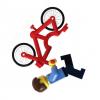
[42125 Alternate] Ferrari Enzo
paave posted a topic in LEGO Technic, Mindstorms, Model Team and Scale Modeling
My next alternate model of 42125: Ferrari Enzo Features: - Opening doors, bonnet, trunk - Independent suspension - Fake engine - Working steering wheel Video: There's much influence of the 8653 set, which is my favorite one. So it's a kind of modern representation I made Rebrickable page: https://rebrickable.com/mocs/MOC-112172/paave/ferrari-enzo -

[MOC] Nissan 180SX Type X
Gray Gear posted a topic in LEGO Technic, Mindstorms, Model Team and Scale Modeling
After what felt like forever I am finally ready to presesnt you my latest MOC: The Nissan 180SX Type X! Building Instructions are live now on Rebrickable, no more waiting this time : Rebrickable The 180SX has always been one of my favorite cars from Japan. I always wanted to build a drift car, and since the 180SX is probably the most popular drift car to ever exist it was a natural choice. Fitted with a full rollcage, a switch to turn off the HICAS w wheel steering system and a front steering with increased turning radius, ackermann and a positive caster angle this car is sure to be a lot of fun on the togue. One of my inspirations was the badass Sil80 from Initial D, driven by Mako and Sayuki. The License Plate is a nod to this Origin. I even made the front Bumper easy to remove/replace, In case I want to do a Silvia front swap myself later Features:- working SR20DET fake engine- 6speed manual transmission with "Safeshift" system- HoG steering with moving steering wheel. - HICAS 4 wheel steering can be turned on or off using a gear in the cabin- Independent suspension all around- Pop up Headlights can be controlled using a gear in the cabin- Opening hood, trunk and doors One of my goals with this MOC was that every bodypanel of the real car could be built in a different color. My blue+White version has all the spice Type X bits in white color, as it is an earlier 180SX that has been facelifted by the Owner to look like a type X. This was often done back when the facelift came out, because the Panels were easy to swap and not that expensive. That's why you see so many 180SX drift cars with mismatched bodypanels: swapping a "new" panel from the scrapyard is was was easy and cheap. My use of a lot of system Bricks combined with a lot of details caused a part count of close to 4200 bricks Of course I used Sariel's model scaler once again: http://scaler.sariel.pl/ The transmission and HICAS 4 wheels steering can be seen from below The rollcage provides a very rigid body, you can pick the car up by the roof no problem :) Because GoBricks had all the bricks I needed in flat silver I decided to make all the Engine, Piping, exhaust and the Rollcage in flat silver color. Why not? Due to the many color change requests I recieved for my R32 I made Instructions for 4 different colorscemes this time, and the Black+Orange version can even be built with LEGO only! Find more Renders of all 4 Versions here: https://bricksafe.com/pages/Gray_Gear/gray-gears-nissan-180sx-type-x/finished-moc Headlights can either use trans clear 2x4 Tile, or Print/Sticker on black 2x4 tile. You'll get the image for the prints with the instructions on Rebrickable. I hope you enjoy my MOC, and I am looking forward to your comments Best regards, Gray Gear Below you can find some more Pictures.




